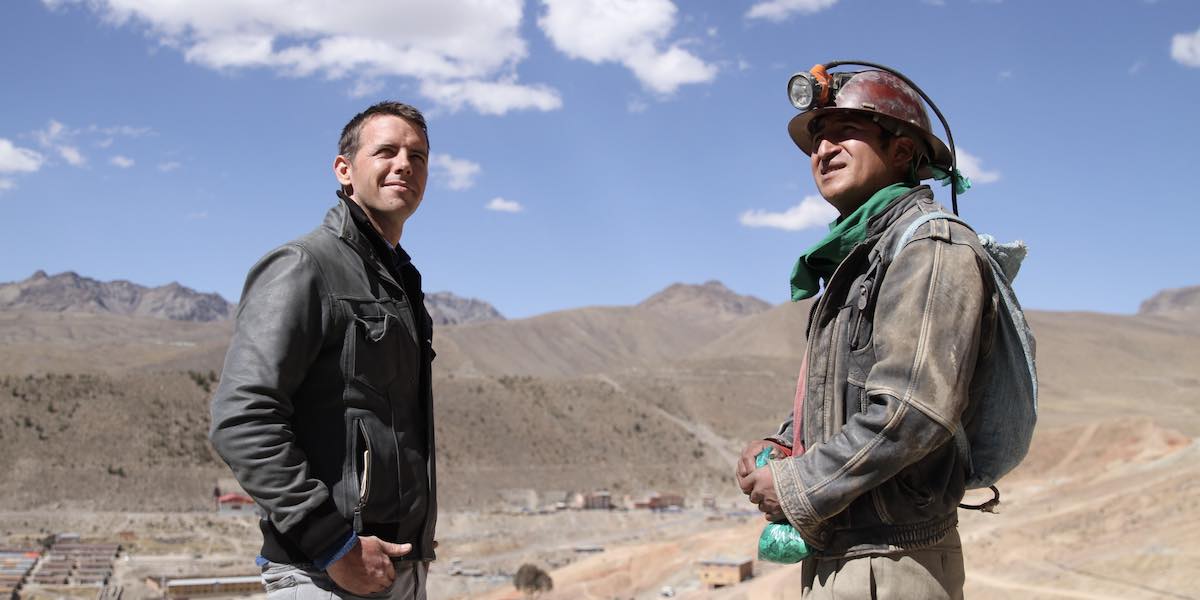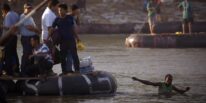Crossing the Andes
Stef Biemans / Netherlands / 2018 / 6 x 25 min




Related Films
 Bad Hombres Stef BiemansBad Hombres explores the most heavily used migration route on Earth. Dutch journalist Stef Biemans travels between Guatemala and the U.S. during the ...
Bad Hombres Stef BiemansBad Hombres explores the most heavily used migration route on Earth. Dutch journalist Stef Biemans travels between Guatemala and the U.S. during the ... Cerro Rico, Tierra Rica(Cerro Rico, Tierra Rica)Juan VallejoThe daily rituals of two mining communities are observed in this strikingly visual and unsparing portrait of life and work in Bolivia’s altiplano, ...
Cerro Rico, Tierra Rica(Cerro Rico, Tierra Rica)Juan VallejoThe daily rituals of two mining communities are observed in this strikingly visual and unsparing portrait of life and work in Bolivia’s altiplano, ... Eternal Amazon(Amazônia Eterna)Belisario FrancaThe Amazon is a vast laboratory for sustainable experiments that are revealing new relationships among human beings, corporations, and the natural ...
Eternal Amazon(Amazônia Eterna)Belisario FrancaThe Amazon is a vast laboratory for sustainable experiments that are revealing new relationships among human beings, corporations, and the natural ... Dicing with death(Route impossible)Tony ComitiDicing with Death, the acclaimed series from Tony Comiti, showcases individuals who brave extreme dangers and risk their lives to earn a living. With ...
Dicing with death(Route impossible)Tony ComitiDicing with Death, the acclaimed series from Tony Comiti, showcases individuals who brave extreme dangers and risk their lives to earn a living. With ... Drowning Letters(Cartas Mojadas)Paula PalaciosThousands of people risk their lives crossing the Mediterranean Sea every year in an attempt to reach the European shores. In her new film, renowned ...
Drowning Letters(Cartas Mojadas)Paula PalaciosThousands of people risk their lives crossing the Mediterranean Sea every year in an attempt to reach the European shores. In her new film, renowned ...Related Subjects
Spanish with English subtitles
The Andes – in all its diversity – is the spine of South America. Journalist Stef Biemans traverses six countries, focusing on work, economy, health, and migration, to find out how South America is doing and which changes are taking place in the continent some call an investors’ paradise, while others say is still a mess… Biemans’ journey starts in Tierra del Fuego and ends in Colombia. Along the way, he searches out small stories about big issues, that illuminate contemporary South America.
Ep. 1. The Man-eating Mountain
Stef Biemans travels the ridge of the Andes and wonders how South Americans are doing in Potosí, the highest city in the world, and once one of its richest, but also one where life can be short. Here, the first coin was struck using silver from the mine of the “rich mountain”, which is still in use. So much silver has been extracted from this imposing mountain, that you could use it to build a bridge to Spain. But you could also build a bridge out of the bones of dead miners and slaves.
Ep. 2. The Skyscraper of Santiago
In the Chilean capital of Santiago, Stef visits South America’s highest skyscraper. It was once built as a symbol of progress, but now the tower represents the dark side to that success story: record depression and suicide rates. In and around this skyscraper, Stef tries to find out where it all went wrong. What are the prerequisites for success and how do people survive in the smog of neoliberalism?
Ep. 3. Technological Paradise
Stef travels to Argentina’s southernmost tip Ushuaia, and discovers an impressive electronics industry among the penguins. Since it’s become known that there are jobs to be had in Tierra del Fuego, the capital of Ushuaia draws countless South American fortune seekers. What is this growth doing to the mountains surrounding the town? The Argentinian government has declared the area a tax-free zone and companies have flooded in with smartphone and television factories. What is the impact on the nature of the surrounding mountains and their biodiversity?
Ep. 4. Eternal Life
The Vilcabamba Valley in Ecuador is known for its healthy old people. The fit old man who interrupts his work in the field to firmly shake Stef Biemans’ hand shows an official proof of identity with a 1913 birthdate. What do spry centenarians in Ecuador right below the equator do to stay healthy, what provisions are there for them should they fall ill, and how do South Americans deal with their elderly?
Ep. 5. My Mother-in-law Stayed at Home
In Latin America, folk tales, songs, novels, and soap operas are not complete without a distrustful mother-in-law. Why is that? And has the role of the mother-in-law changed, now the economy is booming and whole families don’t have to live under one roof anymore? Or are mothers-in-law still as picky and meddlesome as Latino men would have us believe?
Ep. 6. The Mother of Colombia
In the final episode of the series, Stef journeys down the Magdalena River, which originates in the Andes and ends in the Caribbean Sea. This is the most hopeful period in Colombia’s history: the peace treaty has been signed and the country looks towards the future as new roads and bridges are being constructed. At the same time, the Magdalena River, also known as the mother of the country, still means a lot to inhabitants. What will progress destroy?